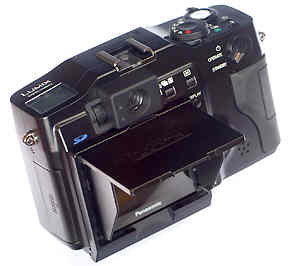 |
||
|
||
| ||
   Classical photo cameras have charm which do not go away with time. The experience proves that they are good and reliable. And now digital camera makers decided to make a benefit out of the spark of this greatness, especially considering that modern digital devices look much greater than their film brothers. Panasonic, together with Leica, released DMC-LC5 camera. I don't know about the contribution of the Leica Camera AG into the digital filling (here you can find a history of changing of the name by the company), but some details of the case which are typical only of this camera, correspond to the image of the legendary company. Note that this camera has a twin which differs just in some details, for example, shapes of the buttons and of the upper panel. This is LEICA DIGILUX . The camera has a classical design. When I unpacked it I found here an external light protector meant for the huge LCD. This very simple detail was created over 100 years ago, and it means that the experience of apparatus building hasn't fallen into oblivion.
   On the photo below you can see removable details: a decorative ring which is put onto a thread for optical attachments, and the protector. Unlike other manufacturers who recommend to use a coin to screw, this company supplied a special piece of iron. The most interesting peculiarity of the camera is focusing. They have done their best to make images as sharp as possible. First of all, we have a large 2.5" LCD of 200,000 pixels, a manual focusing ring on the lens (which controls the engine) and a focusing bracketing mode. Apart from the exposure bracketing, when the camera makes a series of shots with different exposure values to obtain at least one good shot, there is a focus bracketing, when the camera makes 3 shots with a bit different focal lengths.
 In all other respects, this is a typical 4 Mpixel camera. It is written that it has 3.9 Million effective pixels. But let's compare it with the shot resolution which is equal to 2240x1680; if we multiply the numbers we will get 3,763,200, which is close to 3.7 million; this is what the Casio QV-4000 boasts of, having the same frame size. At the same time the Sony DSC-S85 which states that it has 3.9M has a frame of 2272x1704 which is equal to 3,871,488. Well, maybe the remaining pixels are used for something else useful... The camera has a matrix from Panasonic, which uses gapless microlenses in front of sensors and an array of filters which absorb light in the blue, green and red ranges respectively. The camera registers images in additional colors - magenta, yellow and cyan. Color is processed by the Pure Color LCI processor. Images on the matrix are formed by the LEICA DC VARIO - SUMMICRON lens (f=7 - 21mm). The booklet says that the lenses are produced with the help of sizing tools and the quality control system certified by Leica Camera AG and based on the quality standards accepted in the company. The lens is really excellent, and probably complies with the Leica's high standards, but I don't know who produces it together with the Zeiss Vario-Sonnar and the lens from Canon. I can say nothing about a refraction index and dispersion of the glasses but the construction elements are at first glance identical. The history oh photography shows that lenses absolutely identical in optical construction can be produced by different companies. But they always have different mounts, because every production has its own peculiarities. Here it seems to me that the lenses can be different (at least, blooming), but they are produced at the same factory. Can you find differences?

 As compared with the Casio QV 4000, the device has a wider viewing angle, which can be related with the larger matrix.
The resolution of these devices is almost the same, but the DMC LC5 uses noise elimination to the less degree.
 Focal length - 20.74 mm. Resolution charts
are in the frame's center. The noise of the matrix was analyzed with the Thumber program. We made shots with the covered lens and counted the number of "hot pixels" which the brightness over 10. The table shows how the number of hot pixels depends on exposure. Note that lack of hot pixels on shots taken with the Casio camera at the exposure of 3 s is because of the noise elimination mode which gets enabled automatically when exposure is high.
The spectral characteristics of these cameras are different because different filter models were used (blue, green, red of the Casio and magenta, yellow and cyan of the Panasonic). Well, tastes differ, but if you shoot a rainbow or a spectrum of the gitter you will notice a purple band in the blue range. On the photo we increased the contrast and brightness.
 Another example: zonal filters on the light table which uses a luminescent lamp of the conditional color temperature of 8000K.
 Panasonic Lumix DMC-LC5. Aperture - 1:4, exposure - 1/22 s
 Casio QV-4000. Aperture - 1:4, exposure - 1/15 s Red of this camera looks much brighter, and the sensitivity is generally higher, but if you look closer at it, you will see it's not red. The values of brightness for each channel behind the zonal filters are shown in the table:
 The camera has a flash with adjustable power. The flash's sensor is said to come with a digital sensor which reads data on illumination from the sensor on the CCD matrix. It makes possible to change a flash's operation in a wide range, as well as when shooting at the distance of 10 cm. It is so in case of macroshooting inside. But if you are going to brighten shadows in a sunny day and the object doesn't take the whole frame, the device won't react to the light reflected from the object. The frame will be overilluminated.
 You can also attach an external flash with the help of a 1-pin hot shoe. The camera informs about the external flash on the viewfinder's screen. The camera worked excellently with the Sigma EF 500 Super flash meant for Canon cameras. Out of the great number of pins on the hot shoe only the central one was used. Note that it's possible to use both flashes simultaneously. At the same time, the simpler MINOX MF 35 ST flash couldn't work with the camera, though it was recognized. The camera was connected to the computer via USB; it can read SD cards. Note that you can continue shooting with the USB cable connected - you just have to change the view mode for the shooting one. The connectors have a plastic door with a metallic plate inside.
  A special adapting ring is used for optical attachments; it replaces the decorative one. The external thread corresponds to 47 mm, according to my measurements. The camera takes power from a Li-Ion battery of 1400 mAh, it is possible to charge it without taking out of the camera. When the device is in the standby mode, the lens doesn't get in, but its focal length changes, and when you turn on the camera again you should set it anew as well.
  What's else added: you can record 5-sec audio comments, video of 320x240 pixels, 10 fps, video clips are recorded in the QuickTime format; a video-out to transfer images to TV, but only in the frame view mode. Below are the camera's settings. In the playback mode they are obtained by a video signal capture, and in the shooting mode by screen photographing.
      PhotoHere are some shots made with this camera: By clicking on the miniature you can see the source file. Technical data
The camera is well elaborated and looks very reliable
(from the standpoint of digital devices), has an excellent screen
and rich manual settings. Of course, it's impossible to satisfy
everybody, and some of you probably wish that it had a remote control,
shooting control from a computer or matched external flashes.
Write a comment below. No registration needed!
|
Platform · Video · Multimedia · Mobile · Other || About us & Privacy policy · Twitter · Facebook Copyright © Byrds Research & Publishing, Ltd., 1997–2011. All rights reserved. | ||||||||||||||||||||||||||||||||||||||||||||||||||||||||||||||||||||||||||||||||||||||||||||||||||||||||||||||||||||||||||||||||||||||||||